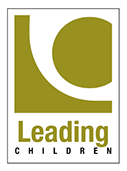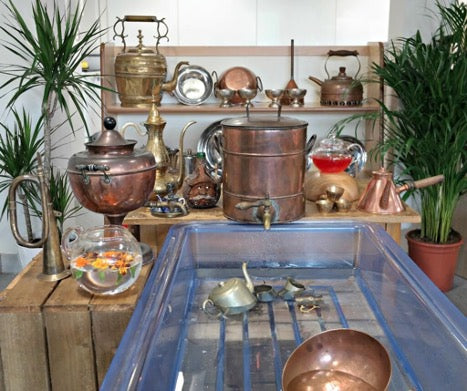My own pedagogy aligns very closely to the Curiosity Approach and has done for decades. In fact none of it is new. I have always observed that children play much more readily with every day, ‘grown up’ items rather than toys; they feel safer and more comfortable in an environment that feels cosy, warm, full of calming colours and as plastic free as possible. Fairy lights have their place in making somewhere feel magical and natural materials and plants bring honest, natural beauty to any setting. Like our mesmerising glimpse into the Reggio Emelia Approach many years ago, we have long since valued the co-constructed curriculum based in the arts and following children’s questions and curiosities. Hence the name of my company, Leading Children.
The founders of The Curiosity Approach seem to have a very solid and well thought out ethos based on Steiner, Montessori, Malaguzzi and the like, and mostly, I agree with their coming away from bright colours, corporate furniture, plastic and especially electronic toys in nursery. But does their approach fit perfectly into Reception and Year One Classrooms? Does having provision = the Curiosity Approach? I’m not so sure and based on the number of schools I have been asked to work with lately, where staff tried to go down the ‘Curiosity Road’ and came unstuck, I offer some thoughts and questions for you to consider.
In every classroom or every single photograph I have ever seen celebrating the curiosity approach, adults have set up a scene, a display, an area or table top. It looks absolutely stunning, irresistible and in a lot of ways, this speaks my language – our company tagline after all is; ‘Let’s make learning irresistible’, but what about children setting up areas or spaces or table tops? And what about children caring for their environment, knowing where everything lives and being able to manage it themselves? I wonder whether a pure Curiosity Approach (CApp) is sustainable in a Reception or Year 1 classroom when it is essential, for me, that children can choose, use, organise and put away everything they come into contact with completely independently. Teachers do not have time to set up a shop display in areas of provision, inside and out as well as fulfil the demands of the curriculum and make sure that there are enhanced provisions to develop children’s interests and their topic.
Many Reception teachers trying to follow the CApp also tend to throw out many resources vital for older children. For example, our curriculum demands that children can identify farm animals from desert animals, pole animals from British wildlife and to name creatures and their habitats. If you have thrown out all your small world because it was plastic or rubber you have a problem! There is absolutely nothing wrong in having a good selection of animal collections as accessories to blocks and other areas, where deconstructed small world play offers children such a rich opportunity to find out about or make sense the world!
The home corner might well have old furniture and old hats and objects rather than anything bought from an Education Catalogue but what about wooden food that supports teaching about food groups? Many children in Bradford, where I am based, cannot name different fruits, vegetables and carbohydrates so although I appreciate that pinecones and sticks do a great job of representing food in a wholly imaginative setting, where children don’t actually know what a strawberry is, we need a good (wooden) representative following a tasty snack!
Where children have experienced the CApp in day care and or nursery, it is important that provision offers a greater degree of sophistication in learning in Reception and then into Year 1. Playing in water with beautiful brass and stainless jugs, ornate tea pots and coffee pots is lovely in nursery and as far as arbitrary measurement and simple ideas about capacity are concerned, it is good, but in Reception we need to introduce the idea that capacity can be measured. Plastic jugs and funnels might seem abhorrent to some, but not everyone can afford to buy metal measuring jugs and containers that show measures clearly. Also, plastic is clear, allowing the child and adult more scope to talk about fullness, emptiness, half full, nearly empty and so on. Clear funnels allow children to see the water decreasing, from the side. Enamel funnels can’t.
Lighting is something that concerns me deeply. It seems people trying to achieve the curiosity approach automatically buy loads of low lighting lamps and the children seem to be learning in semi-darkness for much of the time, especially in our British winters. There have been so many classrooms I have walked into where children have been trying to read or write in dark corners, straining their eyes and struggling to see. Why? Why on earth is the look of a learning environment more important than a child’s eye health?!
Curiosity and investigation are lifelong attitudes within learning that are crucial for life and I believe the Reception and every other classroom should continue to develop them throughout school. However, relying solely on children’s imagination and curiosity is not the full picture of what children need. Many of the children we teach have such incredibly narrow life experiences, their imagination and distinct lack of general knowledge cannot bring enough to the table. Previously, some children in a local Secondary School went away to the Lake District for the first time and on the journey there, were asking what on earth ‘them white blobs were’ in the fields in the distance? We need to teach knowledge and skills to these children for whom the gap between affluent and deprived is so devastatingly wide. Good quality replica animals, cars, construction vehicles, non-fiction books written specifically for Early years and carefully chosen short documentaries are just as crucial to the five year old child. So are masterclasses: an every day 15 minute lesson on how to do something (using a mop and bucket, the next clay skill, using powder paint to mix shades of the same colour, working with a 10s frame or part-part-whole in different directions). Children also need to learn the names of things. Vocabulary in areas of deprivation, especially, is usually a cause for concern. Just playing with found or vintage objects and making them become an imagined something is not necessarily going to support the addition of the thousands of words these children are lacking.
Overall, my message is to not throw the baby out with the bathwater. What your classroom looks like is important – it should be beautiful, clutter free, full of natural materials and yes, old vintage furniture is cheap, more homely and far more interesting than the corporate equivalent. Your walls should be natural, neutral in colour allowing children’s own unadulterated work or photographs of them working, playing and discovering to pop out and be centre stage. Yes, where possible it is far better to swap plastic toys for real objects in a range of natural and recycled materials. But the look is not as important as the learning.
The water area below looks absolutely stunning. I’m not sure how much of it can be reached by a young child, or what happens to trumpets in water but there’s no doubt it looks gorgeous. But what about the children who are into sharks and boats with people fishing in them? What if they want to story tell about fish, divers and treasure? What about pirates and lifeboats and lighthouses? Do these resources really have no place because they don’t suit the décor?

There is no doubt that there should be a whole national revolution against the formality of teaching in Reception and Year One. The whole idea of children being made ready for school makes me sick to my stomach. Schools should get ready for them! But by going overboard, by going too far the other way, we are not helping. We can never afford to allow a new approach to take over everything or we lose. There needs to be balance, there needs to be discussion, careful thinking and the end to teachers blindly following each new fad without really thinking carefully about how it affects the children they teach. Like the good book says: everything in moderation!

